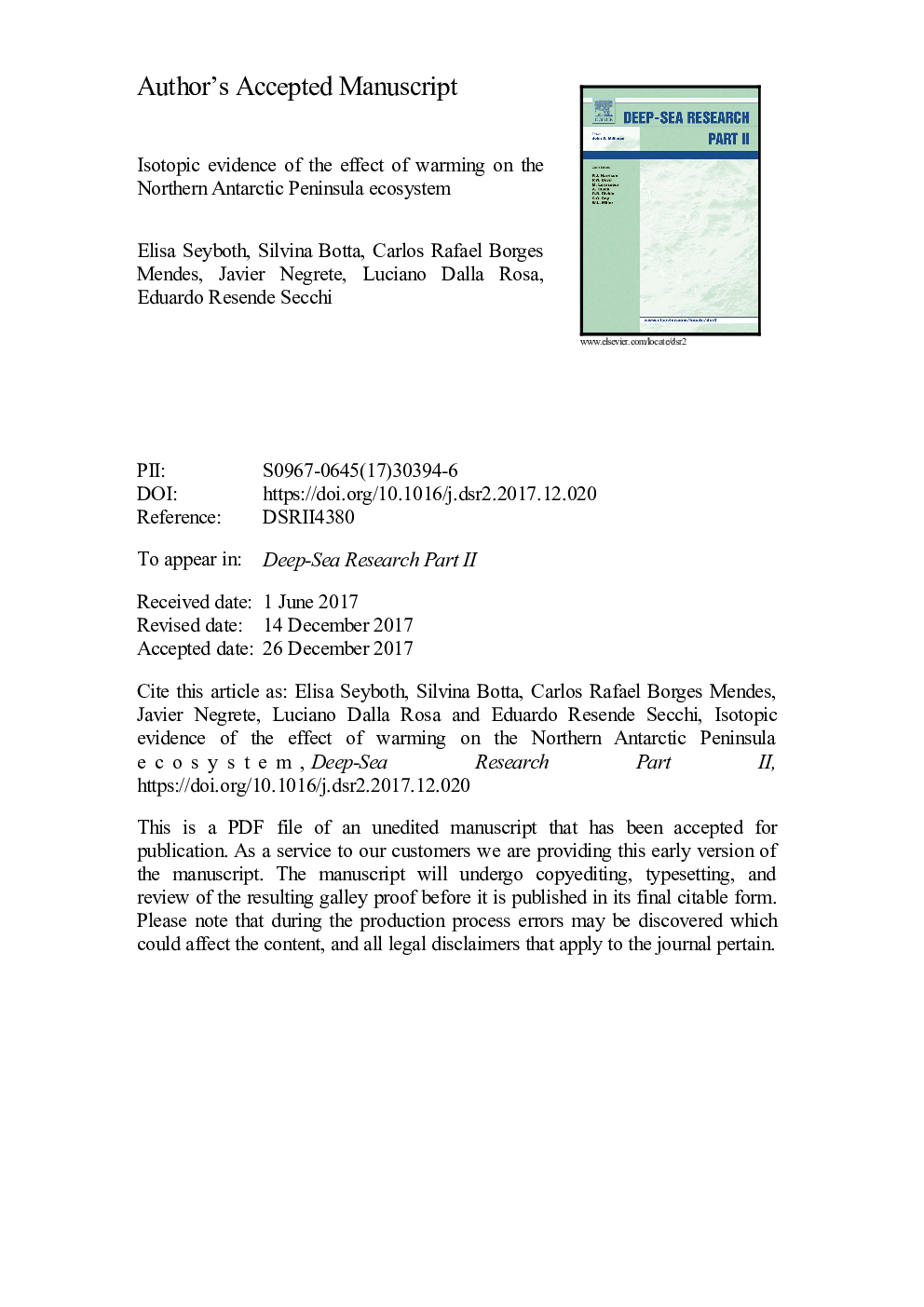| کد مقاله | کد نشریه | سال انتشار | مقاله انگلیسی | نسخه تمام متن |
|---|---|---|---|---|
| 8884432 | 1626393 | 2018 | 27 صفحه PDF | دانلود رایگان |
عنوان انگلیسی مقاله ISI
Isotopic evidence of the effect of warming on the northern Antarctic Peninsula ecosystem
ترجمه فارسی عنوان
شواهد ایزوتوپ اثر گرمایش در اکوسیستم شبه جزیره شمالی قطب
دانلود مقاله + سفارش ترجمه
دانلود مقاله ISI انگلیسی
رایگان برای ایرانیان
کلمات کلیدی
موضوعات مرتبط
مهندسی و علوم پایه
علوم زمین و سیارات
زمین شناسی
چکیده انگلیسی
The Antarctic Peninsula (AP) region is one of the areas under faster warming rates worldwide, and where food web changes have been observed in the last decades. Among these changes are the development of cryptophytes under warmer conditions in detriment of diatoms, and the reduced krill availability in the environment. An isotopic approach was used to investigate whether the temporal and spatial patterns of energy transfer from phytoplankton (using particulate organic matter - POM - as a proxy of primary producers) to baleen whales (humpback - Megaptera novaeanglieae, fin - Balaenoptera physalus, Antarctic minke - Balaenoptera bonaerensis), and killer whales - Orcinus orca - is similar in areas under different effects of warming around the northern Antarctic Peninsula (NAP). Samples of POM (n = 65), krill (n = 29) and skin of baleen (n = 106) and, opportunistically, killer whales (n = 5) were collected in Gerlache and Bransfield Straits (western AP) and the Powell Basin (northeastern AP) during the austral summers of 2013-2016. Mean isotope values for δ13C and δ15N values were, respectively, â26.3â° (± 2.9) and 0.9â° (± 1.7) for POM, â25.6â° (± 0.9) and 5.3â° (± 1.1) for krill, â24.1â° (± 2) and 8.9â° (± 1.5) for humpback, â24.6â° (± 1.2) and 8.2â° (± 0.7) for fin, â24.4â° (± 1.6) and 8.7â° (± 1) for Antarctic minke whales, and â23.6â° (± 1.2) and 8.9â° (± 1.7) for killer whales. Interannual significant differences were found for δ13C values of POM and fin whales' samples, while spatial differences were found for δ13C values of POM samples and humpback whales and for δ15N values of POM, humpback and Antarctic minke whales. Lower δ13C and δ15N values for the base of the food web tended to be observed towards open sea regions (Powell Basin and an area under the influence of the Bellingshausen Sea waters). The isoscapes generated for the baseline of the NAP ecosystem provided unprecedented information, to the best of our knowledge, of how the δ13C and δ15N values of POM varied spatially and temporally in the region. HPLC-CHEMTAX pigment analysis indicated that two of the main phytoplankton groups in the study region were diatoms and cryptophytes. The contribution of these groups to the total phytoplankton biomass was positively and negatively correlated with the POM δ13C values, respectively. Despite the spatial and temporal limited interpretation of our results due to our reduced sampling effort to the east of the AP and to the relatively short temporal range investigated, the differences observed in the isotopic composition are considered representative of contrasting environmental conditions. The present study provides new insights on stable isotope values in the Antarctic ecosystem and may help to foresee the consequences of physico-chemical changes in water properties to the biota due to global warming.
ناشر
Database: Elsevier - ScienceDirect (ساینس دایرکت)
Journal: Deep Sea Research Part II: Topical Studies in Oceanography - Volume 149, March 2018, Pages 218-228
Journal: Deep Sea Research Part II: Topical Studies in Oceanography - Volume 149, March 2018, Pages 218-228
نویسندگان
Elisa Seyboth, Silvina Botta, Carlos Rafael Borges Mendes, Javier Negrete, Luciano Dalla Rosa, Eduardo Resende Secchi,
